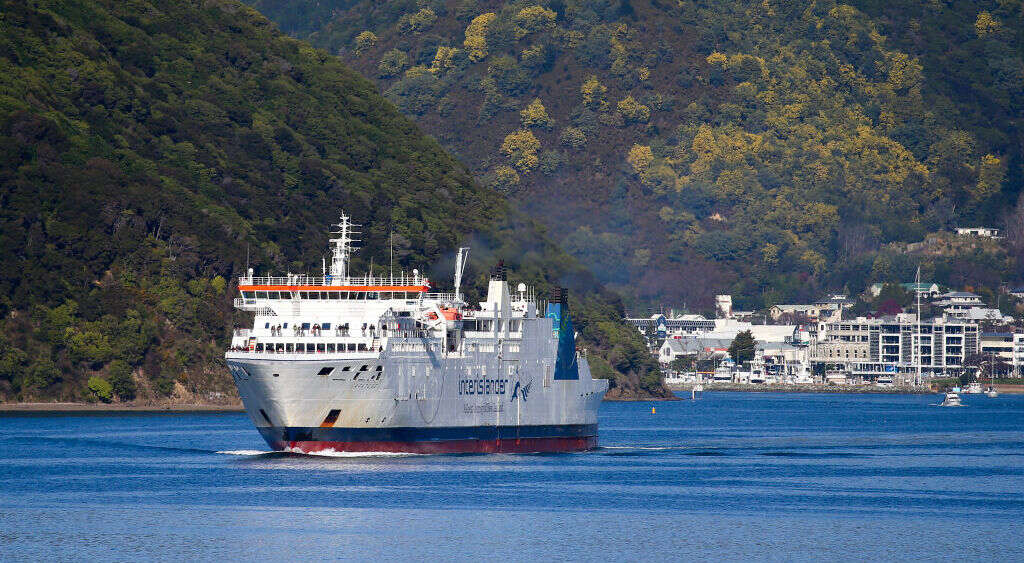

A ferry crosses New Zealand’s Cook Strait, which will in 2025 welcome more fuel-efficient vessels. (Photo by Hagen Hopkins/Getty Images)
- KiwiRail has taken a NZ$350m ($246.3m) green loan, the first for the shipping sector to be certified by the Climate Bonds Initiative.
- It is to help buy new ferries that are expected to reduce carbon emissions by 40% compared with those from the current fleet, says CEO Greg Miller.
- Maritime transport accounts for around 80% of global trade by volume and 70% by value – and 2.89% of global carbon emissions.
Shipping accounts for some 3% of global carbon dioxide emissions, estimates the International Maritime Organization (IMO), but has been dragging its heels on cutting pollution. A recent landmark deal – a green loan – in New Zealand is therefore significant for both decarbonising the maritime sector and the country’s own progress towards achieving net-zero emissions.
KiwiRail, the state operator of train and inter-island ferry operations, in late September became the first company in the shipping sector globally to raise debt certified by Climate Bonds Initiative (CBI), which aims to mobilise debt markets to support climate change solutions.
The NZ$350m ($246.3m) green loan is part of a project to replace the three existing ferries with two new diesel-electric vessels on the Cook Strait route linking the country’s North and South Islands. The rail-enabled ships – total cost NZ$550m – are slated to start operating in 2025 and 2026 and will be bigger, cleaner and more efficient than their predecessors.
“[The transaction] serves to recognise our commitment to reducing our carbon footprint in line with New Zealand’s target of net-zero carbon by 2050,” says KiwiRail group chief executive Greg Miller.
The shipping sector will need clear guidance on how to ensure it is aligned with the targets set out in the Paris Agreement. Lionel Mok, Policy consultant to the Climate Bonds Initiative
The country updated its Nationally Determined Contribution – effectively its climate goal pledged under the 2015 Paris Agreement – on 31 October, when it committed to cutting net greenhouse gas (GHG) emissions by 50% from gross 2005 levels by 2030.
Moreover, the green loan is the first instrument certified under the new Shipping Criteria for the Climate Bonds Standard. Managed by CBI, the Climate Bonds Standard and Certification Scheme seeks to ensure that the proceeds for bonds and loans go to projects consistent with the 2°C warming limit set by the Paris Agreement.
“Gaining the certification for this loan sends a strong signal to the market,” says Gwenael Delattre, head of shipping and offshore finance for Asia-Pacific at Société Générale.
Turning the tanker
According to the latest available figures from the IMO, maritime transport accounted for around 80% of global trade by volume and 70% by value in 2018. The industry also contributed 2.89% of total global anthropogenic CO2 emissions that year, a figure reported in the IMO’s fourth GHG study in March (see chart below).
Shipping remains key to the global economy, but experts say it needs to participate in efforts to decarbonise economies and is finding the process slow and difficult. The IMO, for instance, has set out a strategy for reducing the sector’s GHG emissions to at least 50% below 2008 levels by 2050.
“The industry understands that it must do something,” says Delattre, but there is no clear technology or zero-carbon fuel that ticks all the boxes of being commercially viable, technically safe and scalable.
Gaining CBI certification is at least an indicator of ambitions to make progress on this front.
“The shipping sector will need clear guidance on how to ensure it is aligned with the targets set out in the Paris Agreement,” says Lionel Mok, policy consultant to the CBI, who oversaw the development of the Shipping Criteria. Certification sets best practice in the market for the shipping sector as to what metrics/thresholds should be met to be Paris-aligned, he adds.
To receive it, issuers must show that the expected carbon-equivalent intensity of a ship financed by debt is aligned with the decarbonisation trajectory measured by the ship’s type and size category over the lifetime of the bond or loan, reaching zero emissions by 2050. Issuers must show that each asset funded by the certified bond or loan is operating below the emissions intensity threshold in each year that the bond is outstanding.
KiwiRail attained certification by illustrating the path for its fuel and propulsion systems to achieve zero carbon emissions by 2050.
The new ferries will reduce carbon emissions by 40% compared with the current fleet, says KiwiRail’s Miller. This will be achieved through the diesel-electric, hybrid propulsion system. The battery component will reduce high-level demand on the diesel engines in port while the ships are berthed and during manoeuvring. Moreover, the hull design reduces boat wake energy, thereby improving propeller efficiency and cutting fuel consumption, Miller says.

KiwiRail chief executive Greg Miller says the company's two new ferries will reduce carbon emissions by 40% compared with the current fleet. (Photo courtesy of KiwiRail)
KiwiRail employed Danish naval architects OSK-ShipTech to design ferries that take road, rail and foot passengers and can contribute to meeting its emission-reduction targets of 30% by 2030 and carbon neutrality by 2050.
KiwiRail developed its green borrowing framework for the new ferries alongside consultancy EY as part of the procurement process, says Miller. He adds that “as part of that process, we decided the green certification was achievable”.
The company then developed a managed reduction plan with the guidance of green loan coordinator Société Générale, EY and OSK-ShipTech.
The OSK design – being built in South Korea’s Hyundai Mipo Dockyard – aims to future-proof the ferries by allowing for more battery use as technology improves or for the use of other low-carbon fuel sources as they become more commercially available and the supply more reliable.
More deal details
KiwiRail’s NZ$350m debt facility is financed by Westpac (the facility agent), Bank of America, National Australia Bank and Société Générale.
The company chose the loan format due to its flexibility over bonds and structured it as green. That means the proceeds are ring-fenced to the project, whereas the increasingly popular sustainability-linked format connects interest payments to company performance.
KiwiRail would not disclose the pricing and duration of the loan, but says the lifetime of the transaction exceeds the delivery date for the ferries. “The loan is funding both the construction period and a significant period post-delivery,” says Miller. It also covers the potential for future battery capacity upgrades.
For the shipping industry to decarbonise, there must be a holistic and cooperative approach that involves shipyards, port operators, ship owners, charterers and fuel suppliers. Gwenael Delattre, Société Générale
The purchase of the ferries is part of a NZ$1.45bn state-backed investment programme that will also see redevelopment of the ports in Wellington and Waitohi Picton to accommodate the new ships. Both ships will be significantly larger than the current vessels.
The New Zealand government has committed NZ$435m to the project It is also providing part of the equity for the purchase of the new ferries.
KiwiRail’s maritime operations account for 41% of the company's total carbon emissions, but Miller expects the new ships to meet Interislander emission-cutting targets for 2030 from the time they start operating and to contribute to its overall operational reduction targets.
In addition to paring KiwiRail’s carbon footprint by 16% from its 2012 baseline, Miller says the ferries’ increased rail capacity should encourage more freight onto trains and off roads.
Green loans: more to come?
Despite the positive impact of this transaction, it seems unlikely there will be a raft of deals in the near term to transform the GHG reduction prospects of the sector.
The problem for long-distance shipping is certainty of fuel supplies.
Zero-carbon bunker fuel is expected to enter the global shipping fleet and rapidly scale up from 2030 onwards, as estimated by the World Bank-supported maritime alliance, Getting to Zero Coalition. The coalition’s ambition is to have commercially viable zero-emission vessels operating along deep-sea trade routes by 2030. That will support the IMO’s 2050 target.
New bunker fuels are under development, but it remains unclear which ones will lead the way in replacing current fossil fuels.
Yet success is not just a question of fuel development. For the industry to decarbonise successfully, says Delattre, there must be “a holistic and cooperative approach” that involves multiple parties: shipyards, port operators, ship owners, charterers and fuel suppliers.
That will be a tough task given the international and complex nature of the maritime sector – but such challenges are also opportunities for companies and governments to showcase commitment to decarbonisation.






